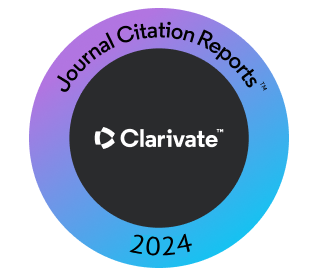The Effect of Substrate Temperature on the Structural Properties of Spray Pyrolysed Lead Sulphide (PbS) Thin Films
DOI:
https://doi.org/10.14500/aro.10044Keywords:
Chemical spray pyrolysis, lead sulphide, semiconductor, thin filmAbstract
Lead sulphide (PbS) films were prepared by the chemical spray pyrolysis technique using a solution of Lead nitrate and thiourea. PbS films were deposited (prepared) on glass substrate at varied temperature (250-350 oC). Effects of substrate temperature on the structural characteristics of the films were studied. The X-ray diffraction patterns’ results reveal that the all of PbS films have a face centered cubic structure. The X-ray diffraction study showed that irrespective of substrate temperature all the films exhibits a preferred orientation along the (200) plane. The degree of preferred orientation increased with the substrate temperature. It was observed that the increase of the substrate temperature increase the diffraction peak intensity of (200) plane which resulted in increase in grain size and good crystallinity of the films.Downloads
References
Abbas, T.A. and Jafar, A.O., 2012. The effect of substrate temperature on the physical properties of spray pyrolysed CdS thin films. Journal of Education and Science, 25(4), pp.77-85.
Anusuya, M., Saravanan, V., Ramesh, T., and Beevi M.M., 2013. Physical Properties of spray pyrolytically LI doped Pbs thin films. Journal of Non-Oxide Glasses, 5(1), pp.33-37.
Ashour, A., Afifi, H. and Mahmoud, S.A., 1995. Structural study of ZnS thin films prepared by spray pyrolysis. Thin Solid Films, 263(2), pp.248-251.
Birks, L., 1946. Particle size determination from X-Ray Line Broadening. Journal of Applied Physics, 17(8), pp.687-692.
Choudhury, N. and Sarma, B., 2009. Structural characterization of lead sulfide thin films by means of X-ray line profile analysis. Bulletin of Materials Science, 32(1), pp.43-47.
Ibrahim, A.E., 2012. Effect of doping by copper on the optical properties on the films prepared by thermal chemical spray. Tikrit Journal of Pure Science, 17(1), pp.215-220.
Ibrahim, A.M., Ismail, R.A. and Ali, A.Y., 2012. Effect of Substrate Temperature on the structural surface morphological and optical properties of nanostractured CdS thin films. Tikrit Journal of Pure Science, 17(2), pp.151-155.
Ismail, R.A. and Faraj, M.G., 2009. Study of optical&electrical properties of CdO prepared by chemical spray pyrolysis, Journal of College of Education, AL- Mustansiriyah University, 3(1), pp.532-539.
Lu, X. and Zhang, M., 2000. Studies on PbS and PbSe detectors for IR system. International Journal of Infrared and MillimeterWaves, 21(10), pp.1697-1701.
Mohammed, A.J., Salim, S.R., Jaleel, M.S. and Hassan, M.A., 2012. Structural Characterization of Lead Sulfide Thin Films by means of FTIR Analysis after Irradiation of β-ray. British Journal of Science, 7(1), pp.35-37.
Masumoto, K., Mochizuki, K., Abe, S., 1992. Solubility range and lattice constant of new quaternary solid solution semiconductor Pb1-x Cax S1-y Sey for mid-infrared lasers. Journal of the Japan Institution of Metals, 56, pp.1479 – 1484.
Rajashree, C., Balu, A.R. and Nagarethinam, V.S., 2014. Substrate temperature effect on the physical properties of spray deposited Lead sulfide thin films suitable for solar control coatings. International Journal of
ChemTech Research. 6(1), pp.347-360.
Raniero, L., Ferreira, C.L., Cruz, L.R., Pinto, A.L. and Alves, R.M.P., 2010. Photoconductivity activation in PbS thin films grown at room temperature by chemical bath deposition. Physica B: Condensed Matter, 405(5), pp.1283-1286.
Seghaier, S., Kamoun, N., Brini, R. and Amara, A.B., 2006. Structural and optical properties of PbS thin films deposited by chemical bath deposition. Materials Chemistry and Physics. 97, pp.71-80.
Sze, S.M. And Ng, K.K. 2007. Physics of semiconductor devices. New Jersey: John Wiley and Sons.
Thiagarajan, R., Beevi, M.M. and Ramesh, T., 2012. Influence of reactant concentration on nanocrystalline PbS thin films prepared by Chemical Spray Pyrolysis. Optoelectronics and Advanced Materials – Rapid Communications, 6(1-2), pp.132-135.
Downloads
Published
How to Cite
Issue
Section
License
Authors who choose to publish their work with Aro agree to the following terms:
-
Authors retain the copyright to their work and grant the journal the right of first publication. The work is simultaneously licensed under a Creative Commons Attribution License [CC BY-NC-SA 4.0]. This license allows others to share the work with an acknowledgement of the work's authorship and initial publication in this journal.
-
Authors have the freedom to enter into separate agreements for the non-exclusive distribution of the journal's published version of the work. This includes options such as posting it to an institutional repository or publishing it in a book, as long as proper acknowledgement is given to its initial publication in this journal.
-
Authors are encouraged to share and post their work online, including in institutional repositories or on their personal websites, both prior to and during the submission process. This practice can lead to productive exchanges and increase the visibility and citation of the published work.
By agreeing to these terms, authors acknowledge the importance of open access and the benefits it brings to the scholarly community.
Accepted 2016-05-07
Published 2014-09-24
















 ARO Journal is a scientific, peer-reviewed, periodical, and diamond OAJ that has no APC or ASC.
ARO Journal is a scientific, peer-reviewed, periodical, and diamond OAJ that has no APC or ASC.